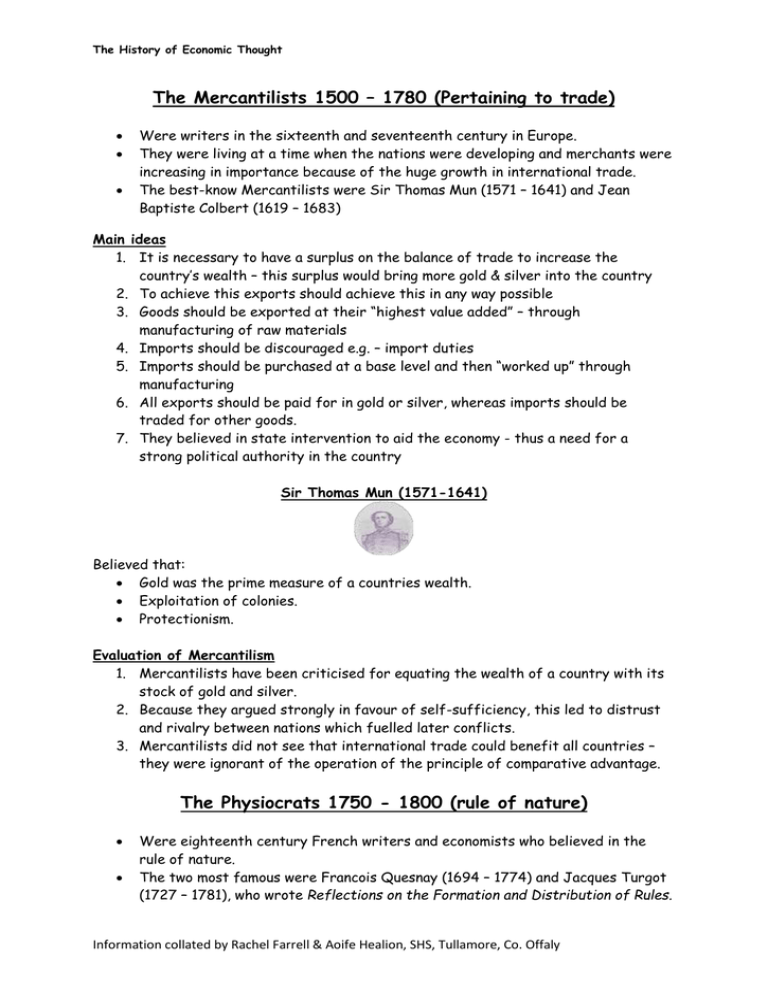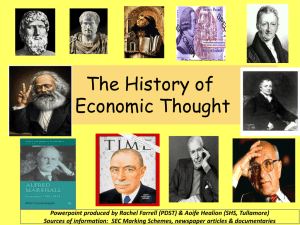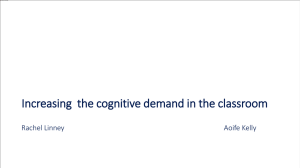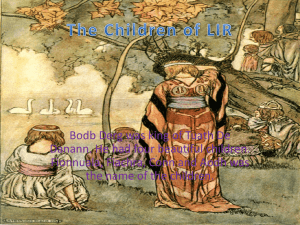Hist of Economic Thought Summary
advertisement

The History of Economic Thought The Mercantilists 1500 – 1780 (Pertaining to trade) Were writers in the sixteenth and seventeenth century in Europe. They were living at a time when the nations were developing and merchants were increasing in importance because of the huge growth in international trade. The best-know Mercantilists were Sir Thomas Mun (1571 – 1641) and Jean Baptiste Colbert (1619 – 1683) Main ideas 1. It is necessary to have a surplus on the balance of trade to increase the country’s wealth – this surplus would bring more gold & silver into the country 2. To achieve this exports should achieve this in any way possible 3. Goods should be exported at their “highest value added” – through manufacturing of raw materials 4. Imports should be discouraged e.g. – import duties 5. Imports should be purchased at a base level and then “worked up” through manufacturing 6. All exports should be paid for in gold or silver, whereas imports should be traded for other goods. 7. They believed in state intervention to aid the economy - thus a need for a strong political authority in the country Sir Thomas Mun (1571-1641) Believed that: Gold was the prime measure of a countries wealth. Exploitation of colonies. Protectionism. Evaluation of Mercantilism 1. Mercantilists have been criticised for equating the wealth of a country with its stock of gold and silver. 2. Because they argued strongly in favour of self-sufficiency, this led to distrust and rivalry between nations which fuelled later conflicts. 3. Mercantilists did not see that international trade could benefit all countries – they were ignorant of the operation of the principle of comparative advantage. The Physiocrats 1750 - 1800 (rule of nature) Were eighteenth century French writers and economists who believed in the rule of nature. The two most famous were Francois Quesnay (1694 – 1774) and Jacques Turgot (1727 – 1781), who wrote Reflections on the Formation and Distribution of Rules. Information collated by Rachel Farrell & Aoife Healion, SHS, Tullamore, Co. Offaly The History of Economic Thought Main ideas 1. No state intervention except to uphold the natural law and to protect private property – this is known as laissez-faire. They believed Human Laws were imperfect and should be kept at a minimum. 2. Agriculture is the source of all wealth (all wealth derives from the soil), whereas manufacturing only changes the nature of wealth while trade only changes its ownership. Those who were not involved in agriculture were considered to be members of a “sterile” or non-productive class. 3. They advocated free international trade. Francois Quesnay (1964 – 1774) Wrote Economic Table published in 1758, made the first attempt to analyse the interdependence of various sectors of the economy. This was a chart that traced the flow of money from one sector of society to another. Quesnay, who was a surgeon by profession, compared the movement of resources from one sector of the economy to another to the movement of blood through the human body. Believed that: Wealth had its origin in agriculture. Private ownership of property important. Non-government intervention (except for laws). Free trade. Evaluation of Physiocrats 1. The Physiocrats provided a firm foundation for later writers who wished to analyse the workings of an economy in greater detail. 2. Most writers since the Physiocrats have accepted the notion of a set of natural laws on which all human actions should be based. The Classical Economists Were mostly English economists in the eighteenth and nineteenth centuries, they were the first real economists in the modern sense of the world. They argued in favour of the maximum freedom for the individual and the minimum state intervention in economic affairs – opposed protectionism. Their writings coincided with the Industrial Revolution in Britain and the development of capitalism. Information collated by Rachel Farrell & Aoife Healion, SHS, Tullamore, Co. Offaly The History of Economic Thought Main Ideas 1. Laissez-faire: The government should only intervene in an economy to raise funds to maintain the legal system, to defend the country and to provide infrastructure. 2. The wages fund theory. Adam Smith (1723 – 1790) Born 1723 in Kirkcaldy, Scotland. Won a scholarship to Oxford, where he first lectured at Edinburgh University and then the Glasgow University where he was appointed a Professor of Moral Philosophy. He studied economics (known then as political economy) as part of philosophy. He rejected the Physiocratic view that all wealth had its origin in agriculture, and gave equal importance to manufacturing. Published “The Wealth of Nations” in 1776. Main Ideas 1. The Market Mechanism – Smith explained how perfect competition worked. If each person pursues their own individual interests, they will benefit society in general – free market and competition. He called it the invisible hand. To earn profits, businessmen must produce what customers want, and the price was a signal to the businessman to produce the goods which the public most wanted. Products in great demand commanded high prices and yielded the most profits. If a good was in short supply its price would rise, and other producers would be attracted into the industry. If a surplus existed, prices fell and some firms left the industry. Supply and demand created the natural price. So Smith favoured free competition and was totally opposed to monopoly. 2. He believed strongly in the Division of Labour as a means by which total production (and therefore wealth) could be increased. By division of labour he meant dividing the process of production into many parts, each done by one man and productivity will increase. Called specialisation. 3. Labour Theory of Value – Smith maintained that labour is the source of all wealth. The value of an item is equal to the amount of labour that goes into producing it. 4. Smith advocated Laissez-faire. Government should not interfere in commerce and trade. The role of the government should be to maintain the legal system, to defend the country and to provide infrastructure. 5. He was an advocate of free international trade – opposed tariffs and quotas. Free trade would make the world better off. He believed that countries, like Information collated by Rachel Farrell & Aoife Healion, SHS, Tullamore, Co. Offaly The History of Economic Thought individuals, should specialise. He developed the idea of absolute advantage; each country produced what it was best at. 6. He laid down “The Canons of Taxation”. While Smith was opposed to government intervention in economic affairs, he did see a limited role for the government in providing a framework and essential services, within which private enterprise could flourish. This framework and essential services should be funded by taxation. Taxation should be based on the following rules or canons: Equity – Taxes should take account of people’s ability to pay the tax Certainty – People should know what their tax is going to be for the coming year, so they can set money aside during the year. Convenience – The method of paying the tax should be suitable to the taxpayer, not to the government. Economy – The cost of administrating the tax should be far less that the income generated by the tax. Evaluation of Smith 1. Smith was writing before the worst effects of the Industrial Revolution. He did not concern himself with social issues arising from laissez-faire, poverty, low wages, long working hours, bad working conditions, exploitation of woman and children etc. 2. He was also naive to assume that individuals pursuing their own advantage will always benefit society as a whole. 3. Despite these faults, Smith’s contribution to the development of the subject cannot be overestimated. He produced the first complete assessment of the workings of an economy, and provided the framework in which subsequent contributions to the subject were made. Thomas Robert Malthus (1766 – 1834) Was educated at St. John’s College, Cambridge, where he studied mathematics and philosophy. He became a clergyman in the Anglican Church. Subsequently he was made Professor of History and Political Economy at the East India Company College at Haileybury (in England) and is considered to be the first professional economist. Malthus is mostly remembered for “Essay on the Principle of Population”, published in 1798. Main ideas 1. Theory of population – In his essay he argued that while population would grow by geometric progression (1,2,4,8,16,32…….) while food supply would only grow by Information collated by Rachel Farrell & Aoife Healion, SHS, Tullamore, Co. Offaly The History of Economic Thought an arithmetic progression (1,2,3,4,5……), thus leading to food shortages. He stated that this crisis could only be solved by war, famine or disease. He therefore saw that there would have to be a check on the growth of population, he identified two types of population checks: Preventative checks are those which lower the birth rate Positive checks are those which increase the death rate He had little or no faith in the working class successfully practising preventative checks. Also being a cleric, he did not believe in artificial methods of contraception. Therefore, he advocated that there was a need for occasional positive checks on the growth of the population. Positive checks include war, disease and famine. 2. Iron Law of Wages – states that if wages rise above the subsistence level (minimum level required for survival), an increase in population results, which again forces wages down to the subsistence level as this would increase the supply of labour. This theory suited employers who felt it justified in paying low wages. Evaluation of Malthus 1. Malthus’s gloomy forecast concerning population growth and starvation did not prove correct for a number of reasons. Improvements in transport and storage meant food became more widely available – less subject to perishability. Improvements in food production techniques (e.g. – Farming – higher yielding of crops) meant that output of food could be increased without increasing the land devoted to agriculture. As people’s income increased, the birth rate dropped, proving that the subsistence theory of wages is incorrect. As standards of living increase, there is a tendency for average family size to fall rather than rise. 2. Malthus is to be credited with focusing attention on the issue of overpopulation which is still very much a problem in many underdeveloped countries today. His theories are still relevant in those parts of the world where famine is a present threat. David Ricardo (1772 – 1823) Born in London to Jewish parents. Ricardo had little formal education, despite this he set himself up as a dealer on the Stock Exchange where he made a fortune. At age 42 he retired and spent the remainder of his life studying and writing about economics. He became a Member of Parliament (MP) in 1820 but died suddenly in 1823. Information collated by Rachel Farrell & Aoife Healion, SHS, Tullamore, Co. Offaly The History of Economic Thought His major work was “Principles of Political Economy and Taxation”, published in 1817, which dominated Classical economics for the next 50 years. Main ideas 1. He introduced the concept of economic rent. This is any payment to a factor of production above its supply price. If food prices increased fertile land would be more profitable. Landlords could then charge extra rent for fertile land – economic rent. Ricardo was not happy about economic rent on land as landlords benefited, but they spent it on non-productive purposes (e.g. - big houses). Industrialists suffered as they had to pay higher wages due to higher food prices. This transfer of wealth from industrialists to landlords angered Ricardo. 2. Like Malthus, Ricardo accepted the subsistence theory of wages. He therefore argued that the rise in wages above the subsistence level would cause population to increase. 3. He advocated free international trade in a laissez-faire society. 4. He developed the Law of Competitive Advantage to explain how countries could benefit from international trade. A country, even though it may be efficient in the production of two goods, should specialise in the good which it is relatively most efficient in and trade it for its other needs. Evaluation of Ricardo 1. Like all main economists of his time, he believed that there should be no intervention by the state to restrict free international trade, he opposed tariffs. He developed the Law of Competitive Advantage, which is his main legacy to economics, to show that the benefits of free trade could be spread among all countries engaged in trade. The Law of Competitive Advantage is still used today to show advantages of free trade between nations. 2. Ricardo also developed the theoretical side of the subject, which had a profound influence on the methods adopted by later writers. Jean Baptists Say (1767 – 1832) A French economist. Began lecturing economics in 1816, was appointed Professor of Political Economy at the College de France in 1831 He is remembered for his “Treatise on Political Economy”, published in 1803, which contained what later became known as the Law of Markets or “Say’s Law”. Say’s Law states that “supply creates its own demand”. Information collated by Rachel Farrell & Aoife Healion, SHS, Tullamore, Co. Offaly The History of Economic Thought He believed that people worked to supply the goods which they could produce most efficiently, so that they could then exchange their surplus production for money, which in turn could exchange for goods which they wanted i.e. demanded. Thus by creating a supply of goods they created a demand for other people’s goods. Therefore, the supply of goods created a demand for goods. As a result, there can never be overproduction of goods – each man’s supply constitutes his demand for other goods and so, the total demand must equal the total supply. If at times some income was saved and not spent on the goods of others the end result would still be the same – the accumulative of savings would lead to drop in interest rates and this would lead to a rise in demand for capital goods – the system was self-adjusting. Say is also credited with the division of the factors of production – land, labour, capital and enterprise. John Stewart Mill (1806 – 1873) John Stewart Mill, of English nationality, was subjected to severe educational pressure by his father. By the age of 13, he had Greek, Latin, mathematics, algebra and philosophy and had read all the major work on economics. In 1823 he joined the East India Company and worked there for 35 years. Like Ricardo, he became an MP. His main work, “Principles of Political Economy”, published in 1848. Main ideas 1. Mill advocated government intervention in the economy if it improved the welfare of society, e.g. – he approved of taxation for a more equal distribution of wealth. 2. He rejected the labour theory of value, stating that both demand and supply were equally important in assessing the value of a product. 3. Along with Ricardo he also identified the concept of economic rent. However, because economic rent is a surplus above the supply price he advocated that it should be taxed, as the tax would have no effect on supply. 4. He was one of the first economists associated with, and to write about the law of diminishing returns. 5. Mill stated that the production and distribution of wealth were two independent processes: Production of wealth was determined by the laws of nature and technology. Distribution of wealth was controlled by man. Information collated by Rachel Farrell & Aoife Healion, SHS, Tullamore, Co. Offaly The History of Economic Thought 6. He advocated the establishment of trade unions to represent labour. Socialism The 19th century saw many social and political changes, which were linked to the changing economic order. The development of capitalism and the Industrial Revolution had led to huge inequality in the distribution of wealth. Poverty flourished; there was appalling working conditions, inadequate wages and bad housing. There was no social welfare system to protect the old, sick or unemployed. All Classical writings accepted the rigid class divisions based on the ownership of private properly and wealth. Karl Marx (1818 – 1883) Karl Marx was born in Germany in 1818, the son of a Jewish lawyer. He attended university and at Bonn and Berlin where is studied philosophy. His well-known political beliefs ensured he did not win the university lectureship that he wanted. He became editor of a Germany newspaper which the government later supressed because of its political editorials. He fled to Paris in 1843 where he married and began a lifelong friendship with Friedrich Engels, a wealthy businessman who supported the Marx family financially and encouraged his interest in economics. Marx and Engels jointly wrote the “The Communist Manifesto”, published in 1848. It was a short book that intended to outline the nature of the communist system, to reveal the historical process of change and to provide a strategy policy for the working class. Main ideas 1. Labour theory - Marx stated that the value of a product was equal the cost of labour necessary to produce the product. Labour was only paid a subsistence level of wages, but was required to work a longer number of hours than was necessary to pay these wages. Therefore, labour was producing surplus value which went as profit for employers. Marx called this “the surplus value” of production. 2. This surplus value of production was used by employers to purchase technology, which would reduce the need for labour, thus causing employment. This weakened labour’s bargaining power when negotiating wage rates – this lead to exploitation of the employed labour force. Information collated by Rachel Farrell & Aoife Healion, SHS, Tullamore, Co. Offaly The History of Economic Thought 3. This would lead to the creation of a two-tiered society, namely “the proletariat” (working class) and “the capitalist” (owners) classes. 4. The combination of the growing number of unemployed and the exploitation of labour would, Marx predicted, lead to a social revolution where the “reserve army of the unemployed” would overthrow the “capitalists” and take control of the factors of production. These factors would then be held in public ownership rather than private ownership. 5. Marx predicted that as technology improved, the production of goods would move towards very large-scale production in order to get the benefits of economies of scale. This would lead to the establishment of oligopolistic production of most mass consumption goods. 6. He also predicted that production would become so efficient that producers would, at times, produce more goods required by consumers, thus leading to trade cycles. Evaluation of Marx 1. The growth of unions ensured protection of working class. 2. Middle & professional classes emerged. 3. Technology did not lead to mass unemployment. 4. Predictions on oligopolies & trade cycles came true. Neo-Classical Economists The neo-classical economists were writings in the nineteenth and twentieth centuries. They concentrated on microeconomics and the function of the market system and completion in the market place. Alfred Marshall (1842 – 1924) An English economist. He became Professor of Political Economy at Cambridge in 1855. Marshall published “Principles of Economics” in 1890. He refined the ideas of the earlier Classical writers and used mathematical methods to explain how price and input were determined – he was the first economist to use econometrics, i.e. – the use of maths to illustrate economic theory. Main ideas 1. Marshall, along with other neo-classical economists, developed the concept of marginal utility theory of value – the value of a commodity determined by its ability to satisfy human needs. Information collated by Rachel Farrell & Aoife Healion, SHS, Tullamore, Co. Offaly The History of Economic Thought 2. It was Marshall who first introduced the idea of diminishing utility (DMU) – the more one has of a good the less extra value from each extra unit. Thus he saw both demand and supply playing a role in determining value. He linked both demand and supply to the blade of scissors interesting each other (Marshall’s scissors analogy - demand & supply are interdependent just like the blades of a scissors). 3. He was the first person to apply the term “elasticity of demand” to explain the reaction of demand to small changes in price. 4. It was Marshall who first saw that the return on factors of production was based on their marginal revenue productivity, i.e. – the return to each was determined by the return achieved from the last unit of FOP. 5. He introduced the notion of differentiating between the long run and the short run for production processes – in the short run there was always at least one fixed factor of production, whereas in the long run all factors of production were variable. 6. This led him to develop the concept of “Quasi-rent”, which he saw as economic rent earned by labour in the short run, which was eliminated in the long run by the increase in the supply of that labour. 7. Competition and Government regulation – Marshall favoured free enterprise but saw the need for a certain amount of regulation especially in control of monopolies. Keynesian (neo-Keynesians) Economists Those economists who are in broad agreement with the general arguments put forward by Keynes (below) are called Keynesians or neo-Keynesians. While these writers do not constitute a single united group in agreement on all economic issues, they generally support the following: Aggregate demand plays an important role in determining the level of output. Economies can settle at position with high unemployment, where unemployment shows no tendency to fall. Governments, by use of fiscal policy, can increase aggregate demand to reduce unemployment. John Maynard Keynes (1883 – 1946) Keynes was born at Cambridge and educated at Cambridge University, where he studied economics under Alfred Marshall. After a period in the civil service, he became a lecturer at Cambridge; in 1911 he became editor of the Economic Journal. Information collated by Rachel Farrell & Aoife Healion, SHS, Tullamore, Co. Offaly The History of Economic Thought During the First World War, Keynes held a post at the Treasury (The British Department of Finance) and he represented Britain at the Peace Conference in Versailles in 1919. Keynes’s major work, “The General Theory of Employment, Interest and Money” was published in 1936. Main ideas 1. Government action in recession. Keynes stated that the cure for recession was government action. Government should spend on capital projects and cut taxes to stimulate consumer spending. He called it “pump-priming” the economy. Government spending on public works will lead to employment, to private business expansion, to growth. Importantly there was a multiplier effect. 2. He did not agree with the concept of laissez-faire. He felt that governments through fiscal policy could help control economies. Thus he advocated government intervention to regulate the economy. 3. Savings and Investments. The classical economists believed that savings were always equal to investment, as all money saved would be put back into the economy. Keynes disagrees with this theory as savers and investors were two distinct groups of people within the same economy. He stated that savings might be greater than the amount of entrepreneurs are willing to invest. If this happened there would be a decline in consumption, and the capital stock of the country would be greater than what’s required. A low level of consumption causes unemployment – may lead to recession. 4. Keynes discovered the multiplier effect, which showed that if government increased expenditure then GNP will increase by a multiple of that. This was a great Keynesian insight. So if the multiplier was 2.5, then government expenditure of 100m, would give GNP growth of 250m. 5. He developed an interest rate theory called the Liquidity Preference Theory; this stated that the rate of interest settles at the level which brings about an equal supply of demand for money. In this theory, the supply of money means the amount of money in circulation, while the demand for money means the reasons why people want to hold onto money rather than investment it. He pointed out that the supply of money is fixed at any given time by the Central Bank, while the demand for money was determined by the amount of money needed for transactionary – arises from the fact that most transitions involve an exchange of money, precautionary – people often demand money as a precaution against an uncertain future and speculative motive demanding money arises in situation where holding money is perceived to be less risky than the alternative of lending or investing the money, 6. Keynes advocated that investment decisions depend on expectations not the rate of interest. Information collated by Rachel Farrell & Aoife Healion, SHS, Tullamore, Co. Offaly The History of Economic Thought Monetarism This is the name given to the theory of macro-economics which suggests that monetary policy should be the main instrument used by the government to manage the economy. Monetarism first emerged in the 1960’s when it seemed that Keynesian theories were unable to come up with solutions to economic problems at that time, in particular inflation. Milton Friedman (1912 – 2009) An American national. His publications include “Inflation, Causes and Consequences” and “A monetary History of the United states”. Main ideas 1. The monetarists argued that monetary policy should be the main instrument used by the government to manage the economy. 2. To control inflation they argued that there should be tight control on the money supply (company’s paying low wages), loans restricted & high interest rates. This would reduce consumer’s ability to pay high prices for goods. In turn this will leads to increased competitiveness, cheaper exports and job creation in the long run. 3. They accepted that the control of inflation has to be a propriety over employment in the short run. Therefore they say the initial implementation of a monetary policy may be accompanied by short-term high unemployment. 4. They advocated a laissez-faire style of economy with very little government interference in economic affairs. As a consequence they also advocated privatization of all government-owned or controlled business activities. Supply-Siders (late twentieth century) A group of economists who argue that an economy should be developed by stimulating the supply of goods and services rather than trying to stimulate demand. This can be done by reducing taxes; this would encourage work and investment and would increase government revenue. They also advocate deregulation and privatisation to encourage competition this in turn would increase production & reduce prices. Evaluation of Supply-Siders Information collated by Rachel Farrell & Aoife Healion, SHS, Tullamore, Co. Offaly The History of Economic Thought 1. Controversial because it advocates reduction of higher rates of tax which benefits the wealthy. 2. However supply siders claim that reducing tax rates will lead to increased tax revenue. 3. This is because increasing tax rates is a disincentive to work and invest. Information collated by Rachel Farrell & Aoife Healion, SHS, Tullamore, Co. Offaly









